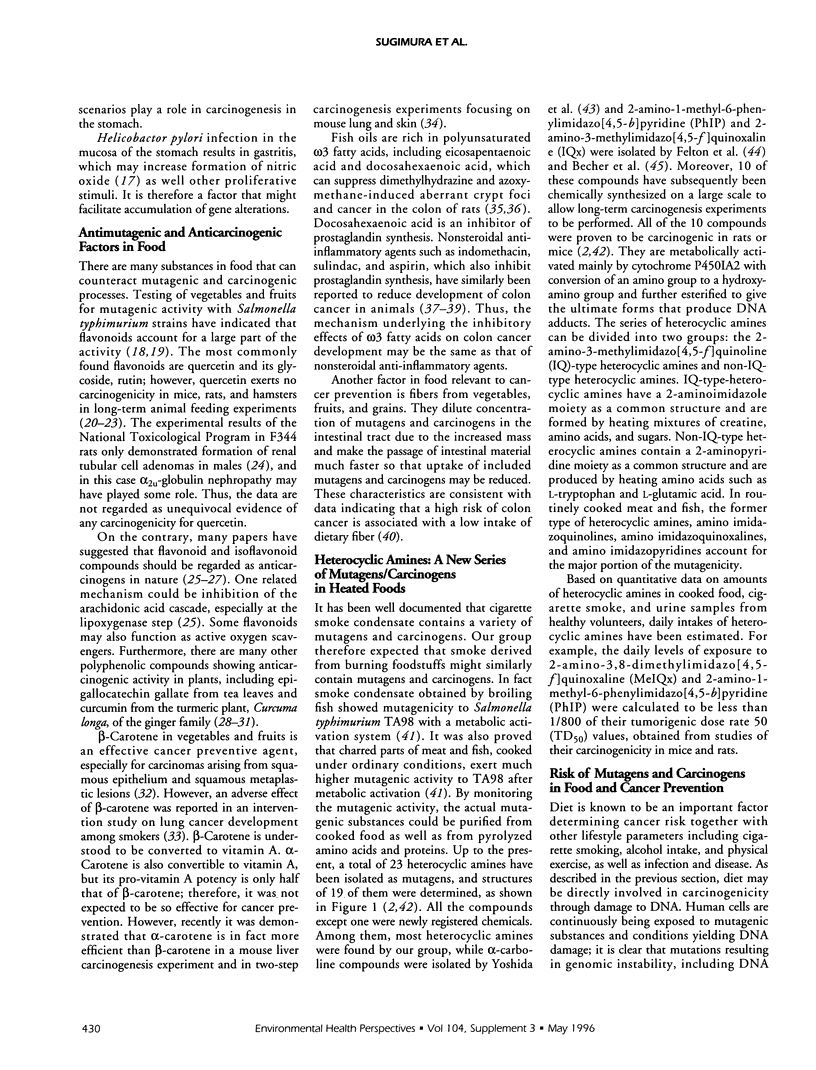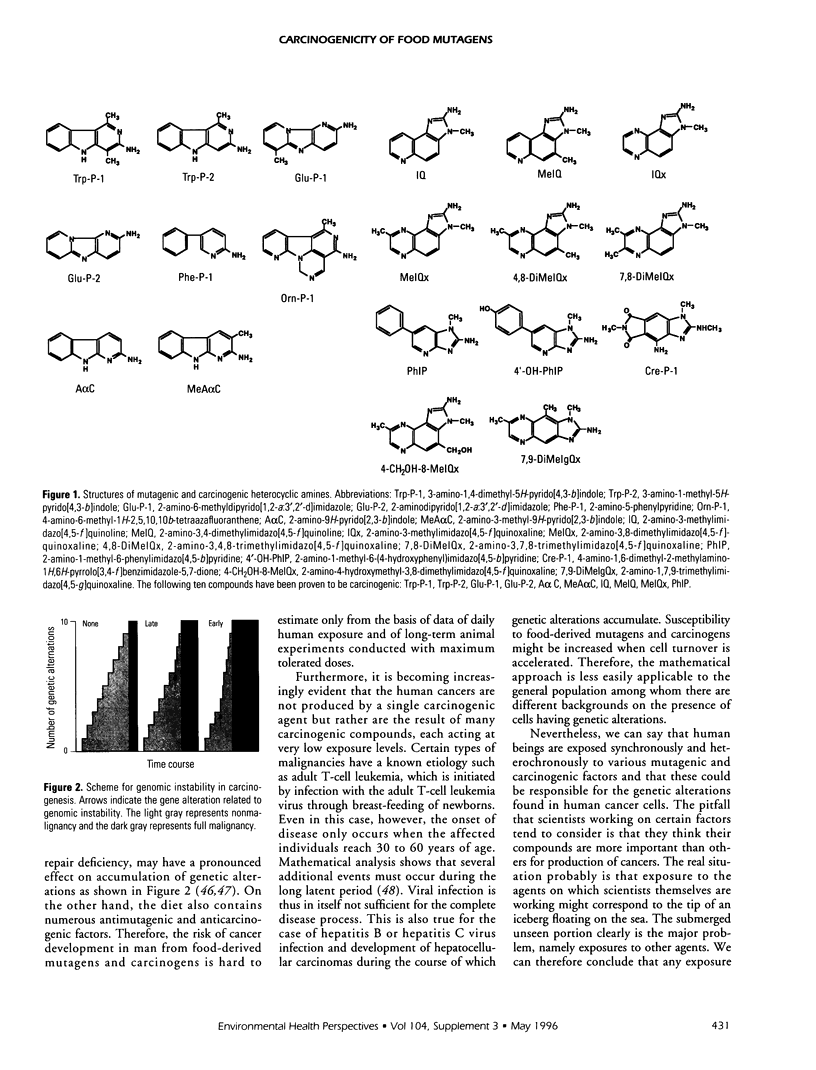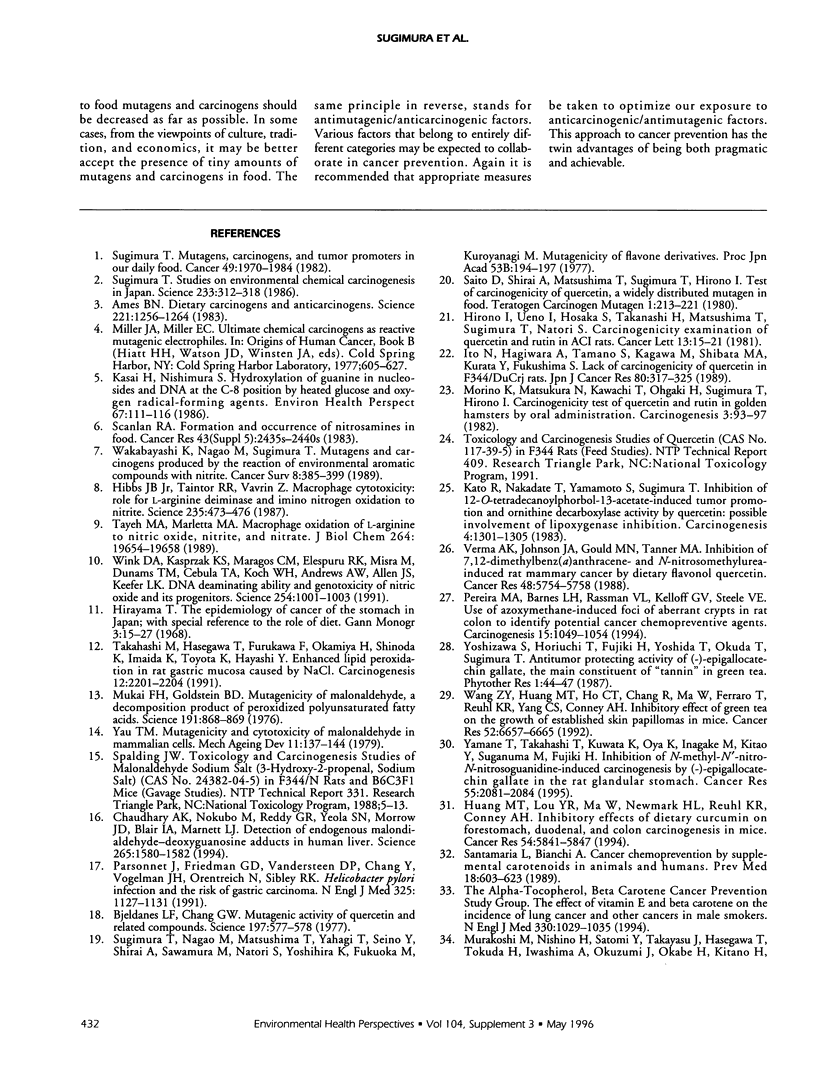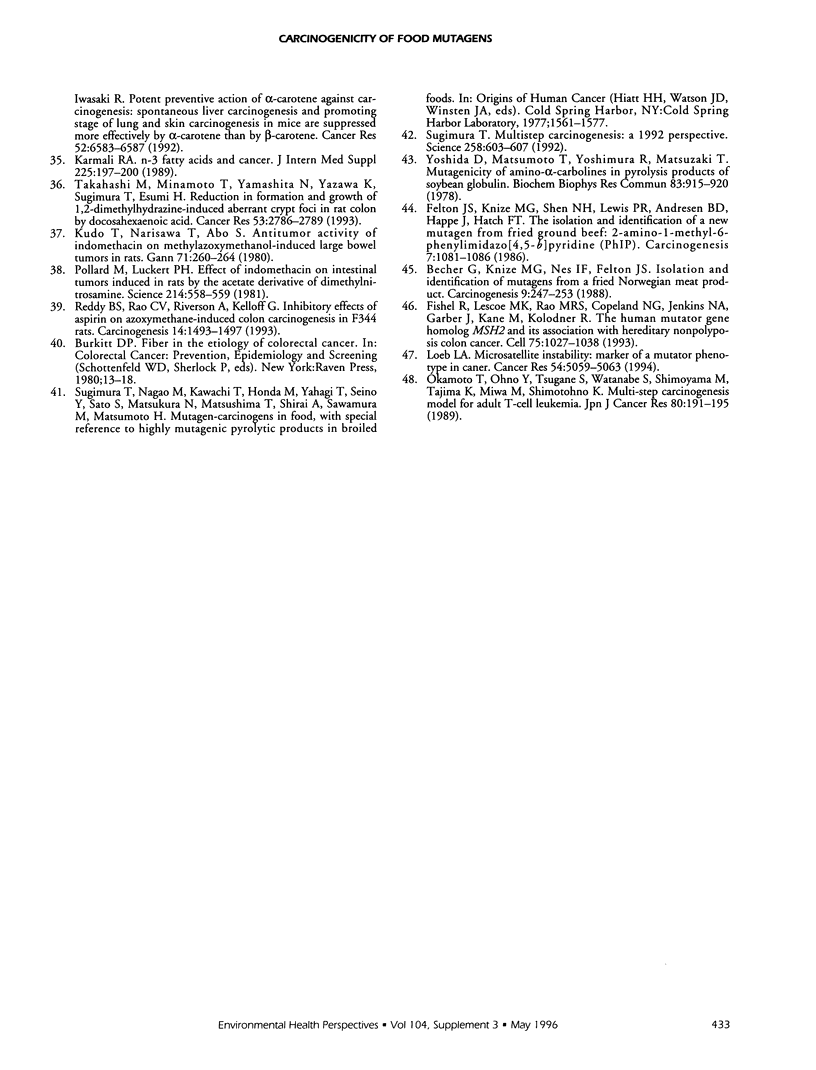Abstract
Cancer cells are produced by the accumulation of genetic alterations in somatic cells. Those genetic alterations are produced by xenobiotics, which enter the human body from the environment, and by autobiotics, which are produced in the human body. Food contains many different types of xenobiotic mutagens/carcinogens and tumor promoters. Food can influence the formation of autobiotic mutagens/carcinogens and give rise to tumor-promoting conditions. In spite of this, it can also contain many antimutagenic, anticarcinogenic, and antitumor-promoting substances. Carcinogenic risk and anticarcinogenic efficacy are hard to express quantitatively; however, holistic approaches that are designed to improve lifestyle are realistic for cancer prevention.
Full text
PDF




Selected References
These references are in PubMed. This may not be the complete list of references from this article.
- Ames B. N. Dietary carcinogens and anticarcinogens. Oxygen radicals and degenerative diseases. Science. 1983 Sep 23;221(4617):1256–1264. doi: 10.1126/science.6351251. [DOI] [PubMed] [Google Scholar]
- Becher G., Knize M. G., Nes I. F., Felton J. S. Isolation and identification of mutagens from a fried Norwegian meat product. Carcinogenesis. 1988 Feb;9(2):247–253. doi: 10.1093/carcin/9.2.247. [DOI] [PubMed] [Google Scholar]
- Bjeldanes L. F., Chang G. W. Mutagenic activity of quercetin and related compounds. Science. 1977 Aug 5;197(4303):577–578. doi: 10.1126/science.327550. [DOI] [PubMed] [Google Scholar]
- Chaudhary A. K., Nokubo M., Reddy G. R., Yeola S. N., Morrow J. D., Blair I. A., Marnett L. J. Detection of endogenous malondialdehyde-deoxyguanosine adducts in human liver. Science. 1994 Sep 9;265(5178):1580–1582. doi: 10.1126/science.8079172. [DOI] [PubMed] [Google Scholar]
- Felton J. S., Knize M. G., Shen N. H., Lewis P. R., Andresen B. D., Happe J., Hatch F. T. The isolation and identification of a new mutagen from fried ground beef: 2-amino-1-methyl-6-phenylimidazo[4,5-b]pyridine (PhIP). Carcinogenesis. 1986 Jul;7(7):1081–1086. doi: 10.1093/carcin/7.7.1081. [DOI] [PubMed] [Google Scholar]
- Fishel R., Lescoe M. K., Rao M. R., Copeland N. G., Jenkins N. A., Garber J., Kane M., Kolodner R. The human mutator gene homolog MSH2 and its association with hereditary nonpolyposis colon cancer. Cell. 1993 Dec 3;75(5):1027–1038. doi: 10.1016/0092-8674(93)90546-3. [DOI] [PubMed] [Google Scholar]
- Hibbs J. B., Jr, Taintor R. R., Vavrin Z. Macrophage cytotoxicity: role for L-arginine deiminase and imino nitrogen oxidation to nitrite. Science. 1987 Jan 23;235(4787):473–476. doi: 10.1126/science.2432665. [DOI] [PubMed] [Google Scholar]
- Hirono I., Ueno I., Hosaka S., Takanashi H., Matsushima T., Sugimura T., Natori S. Carcinogenicity examination of quercetin and rutin in ACI rats. Cancer Lett. 1981 Jun;13(1):15–21. doi: 10.1016/0304-3835(81)90081-1. [DOI] [PubMed] [Google Scholar]
- Huang M. T., Lou Y. R., Ma W., Newmark H. L., Reuhl K. R., Conney A. H. Inhibitory effects of dietary curcumin on forestomach, duodenal, and colon carcinogenesis in mice. Cancer Res. 1994 Nov 15;54(22):5841–5847. [PubMed] [Google Scholar]
- Ito N., Hagiwara A., Tamano S., Kagawa M., Shibata M., Kurata Y., Fukushima S. Lack of carcinogenicity of quercetin in F344/DuCrj rats. Jpn J Cancer Res. 1989 Apr;80(4):317–325. doi: 10.1111/j.1349-7006.1989.tb02313.x. [DOI] [PMC free article] [PubMed] [Google Scholar]
- Kasai H., Nishimura S. Hydroxylation of guanine in nucleosides and DNA at the C-8 position by heated glucose and oxygen radical-forming agents. Environ Health Perspect. 1986 Aug;67:111–116. doi: 10.1289/ehp.8667111. [DOI] [PMC free article] [PubMed] [Google Scholar]
- Kato R., Nakadate T., Yamamoto S., Sugimura T. Inhibition of 12-O-tetradecanoylphorbol-13-acetate-induced tumor promotion and ornithine decarboxylase activity by quercetin: possible involvement of lipoxygenase inhibition. Carcinogenesis. 1983 Oct;4(10):1301–1305. doi: 10.1093/carcin/4.10.1301. [DOI] [PubMed] [Google Scholar]
- Kudo T., Narisawa T., Abo S. Antitumor activity of indomethacin on methylazoxymethanol-induced large bowel tumors in rats. Gan. 1980 Apr;71(2):260–264. [PubMed] [Google Scholar]
- Loeb L. A. Microsatellite instability: marker of a mutator phenotype in cancer. Cancer Res. 1994 Oct 1;54(19):5059–5063. [PubMed] [Google Scholar]
- Morino K., Matsukara N., Kawachi T., Ohgaki H., Sugimura T., Hirono I. Carcinogenicity test of quercetin and rutin in golden hamsters by oral administration. Carcinogenesis. 1982;3(1):93–97. doi: 10.1093/carcin/3.1.93. [DOI] [PubMed] [Google Scholar]
- Mukai F. H., Goldstein B. D. Mutagenicity of malonaldehyde, a decomposition product of peroxidized polyunsaturated fatty acids. Science. 1976 Feb 27;191(4229):868–869. doi: 10.1126/science.766187. [DOI] [PubMed] [Google Scholar]
- Okamoto T., Ohno Y., Tsugane S., Watanabe S., Shimoyama M., Tajima K., Miwa M., Shimotohno K. Multi-step carcinogenesis model for adult T-cell leukemia. Jpn J Cancer Res. 1989 Mar;80(3):191–195. doi: 10.1111/j.1349-7006.1989.tb02289.x. [DOI] [PMC free article] [PubMed] [Google Scholar]
- Parsonnet J., Friedman G. D., Vandersteen D. P., Chang Y., Vogelman J. H., Orentreich N., Sibley R. K. Helicobacter pylori infection and the risk of gastric carcinoma. N Engl J Med. 1991 Oct 17;325(16):1127–1131. doi: 10.1056/NEJM199110173251603. [DOI] [PubMed] [Google Scholar]
- Pereira M. A., Barnes L. H., Rassman V. L., Kelloff G. V., Steele V. E. Use of azoxymethane-induced foci of aberrant crypts in rat colon to identify potential cancer chemopreventive agents. Carcinogenesis. 1994 May;15(5):1049–1054. doi: 10.1093/carcin/15.5.1049. [DOI] [PubMed] [Google Scholar]
- Pollard M., Luckert P. H. Effect of indomethacin on intestinal tumors induced in rats by the acetate derivative of dimethylnitrosamine. Science. 1981 Oct 30;214(4520):558–559. doi: 10.1126/science.7291992. [DOI] [PubMed] [Google Scholar]
- Reddy B. S., Rao C. V., Rivenson A., Kelloff G. Inhibitory effect of aspirin on azoxymethane-induced colon carcinogenesis in F344 rats. Carcinogenesis. 1993 Aug;14(8):1493–1497. doi: 10.1093/carcin/14.8.1493. [DOI] [PubMed] [Google Scholar]
- Saito D., Shirai A., Matsushima T., Sugimura T., Hirono I. Test of carcinogenicity of quercetin, a widely distributed mutagen in food. Teratog Carcinog Mutagen. 1980;1(2):213–221. doi: 10.1002/tcm.1770010209. [DOI] [PubMed] [Google Scholar]
- Santamaria L., Bianchi A. Cancer chemoprevention by supplemental carotenoids in animals and humans. Prev Med. 1989 Sep;18(5):603–623. doi: 10.1016/0091-7435(89)90033-9. [DOI] [PubMed] [Google Scholar]
- Scanlan R. A. Formation and occurrence of nitrosamines in food. Cancer Res. 1983 May;43(5 Suppl):2435s–2440s. [PubMed] [Google Scholar]
- Sugimura T. Multistep carcinogenesis: a 1992 perspective. Science. 1992 Oct 23;258(5082):603–607. doi: 10.1126/science.1411570. [DOI] [PubMed] [Google Scholar]
- Sugimura T. Mutagens, carcinogens, and tumor promoters in our daily food. Cancer. 1982 May 15;49(10):1970–1984. doi: 10.1002/1097-0142(19820515)49:10<1970::aid-cncr2820491005>3.0.co;2-f. [DOI] [PubMed] [Google Scholar]
- Sugimura T. Studies on environmental chemical carcinogenesis in Japan. Science. 1986 Jul 18;233(4761):312–318. doi: 10.1126/science.3088728. [DOI] [PubMed] [Google Scholar]
- Takahashi M., Hasegawa T., Furukawa F., Okamiya H., Shinoda K., Imaida K., Toyoda K., Hayashi Y. Enhanced lipid peroxidation in rat gastric mucosa caused by NaCl. Carcinogenesis. 1991 Dec;12(12):2201–2204. doi: 10.1093/carcin/12.12.2201. [DOI] [PubMed] [Google Scholar]
- Takahashi M., Minamoto T., Yamashita N., Yazawa K., Sugimura T., Esumi H. Reduction in formation and growth of 1,2-dimethylhydrazine-induced aberrant crypt foci in rat colon by docosahexaenoic acid. Cancer Res. 1993 Jun 15;53(12):2786–2789. [PubMed] [Google Scholar]
- Tayeh M. A., Marletta M. A. Macrophage oxidation of L-arginine to nitric oxide, nitrite, and nitrate. Tetrahydrobiopterin is required as a cofactor. J Biol Chem. 1989 Nov 25;264(33):19654–19658. [PubMed] [Google Scholar]
- Verma A. K., Johnson J. A., Gould M. N., Tanner M. A. Inhibition of 7,12-dimethylbenz(a)anthracene- and N-nitrosomethylurea-induced rat mammary cancer by dietary flavonol quercetin. Cancer Res. 1988 Oct 15;48(20):5754–5758. [PubMed] [Google Scholar]
- Wakabayashi K., Nagao M., Sugimura T. Mutagens and carcinogens produced by the reaction of environmental aromatic compounds with nitrite. Cancer Surv. 1989;8(2):385–399. [PubMed] [Google Scholar]
- Wang Z. Y., Huang M. T., Ho C. T., Chang R., Ma W., Ferraro T., Reuhl K. R., Yang C. S., Conney A. H. Inhibitory effect of green tea on the growth of established skin papillomas in mice. Cancer Res. 1992 Dec 1;52(23):6657–6665. [PubMed] [Google Scholar]
- Wink D. A., Kasprzak K. S., Maragos C. M., Elespuru R. K., Misra M., Dunams T. M., Cebula T. A., Koch W. H., Andrews A. W., Allen J. S. DNA deaminating ability and genotoxicity of nitric oxide and its progenitors. Science. 1991 Nov 15;254(5034):1001–1003. doi: 10.1126/science.1948068. [DOI] [PubMed] [Google Scholar]
- Yamane T., Takahashi T., Kuwata K., Oya K., Inagake M., Kitao Y., Suganuma M., Fujiki H. Inhibition of N-methyl-N'-nitro-N-nitrosoguanidine-induced carcinogenesis by (-)-epigallocatechin gallate in the rat glandular stomach. Cancer Res. 1995 May 15;55(10):2081–2084. [PubMed] [Google Scholar]
- Yau T. M. Mutagenicity and cytotoxicity of malonaldehyde in mammalian cells. Mech Ageing Dev. 1979 Sep;11(2):137–144. doi: 10.1016/0047-6374(79)90031-9. [DOI] [PubMed] [Google Scholar]
- Yoshida D., Matsumoto T., Yoshimura R., Matsuzaki T. Mutagenicity of amino-alpha-carbolines in pyrolysis products of soybean globulin. Biochem Biophys Res Commun. 1978 Aug 14;83(3):915–920. doi: 10.1016/0006-291x(78)91482-1. [DOI] [PubMed] [Google Scholar]


